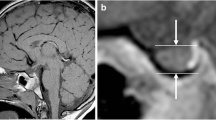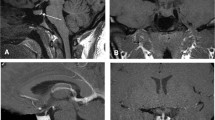Abstract
Apart from the radiologic features regarding size and invasiveness, we had noticed some differences in morphology among types of pituitary adenomas. We conducted this study to verify the differences in radiologic morphology between growth hormone producing pituitary adenomas (GHoma) and nonfunctioning pituitary adenomas (NFoma). Pre-surgical magnetic resonance images (MRIs) were assessed in 50 cases of GHoma and 50 cases of NFoma. Geometric parameters on MRI were set in accordance with sellar anatomy. Intensity of T1-weighted image was not different between the two groups, but hypo-intensity of T2-weighted image was more frequently seen in GHoma. Predominant inferior extension of tumor was seen mostly in GHoma (88 vs. 38 %). Extension of the tumor to the superior compartment of cavernous sinus was more frequent in NFoma. Pituitary gland was generally located superior to GHoma and postero-superior to NFoma. Growth characteristics of pituitary adenoma were confirmed to differ between GHoma and NFoma.



Similar content being viewed by others
References
Campero A, Martins C, Yasuda A, Rhoton AL Jr (2008) Microsurgical anatomy of the diaphragma sellae and its role in directing the pattern of growth of pituitary adenomas. Neurosurgery 62:717–723
Songtao Q, Yuntao L, Jun P, Chuanping H, Xiaofeng S (2009) Membranous layers of the pituitary gland: histological anatomic study and related clinical issues. Neurosurgery 64:1–9
Tang YC, Zhao ZM, Lin XT, Sun B, Fan LZ, Hou ZY, Qi HT, Li ZP, Liu SW (2010) The thin sectional anatomy of the sellar region with MRI correlation. Surg Radiol Anat 32:573–580
Vieira JO Jr, Cukiert A, Liberman B (2006) Evaluation of magnetic resonance imaging criteria for cavernous sinus invasion in patients with pituitary adenomas: logistic regression analysis and correlation with surgical findings. Surg Neurol 65:130–135
Yasuda A, Campero A, Martins C, Rhoton AL Jr, Ribas GC (2004) The medial wall of the cavernous sinus: microsurgical anatomy. Neurosurgery 55:179–189
Yilmazlar S, Kocaeli H, Eyigor O, Hakyemez B, Korfali E (2008) Clinical importance of the basal cavernous sinuses and cavernous carotid arteries relative to the pituitary gland and macroadenomas: quantitative analysis of the complete anatomy. Surg Neurol 70:165–174
Cottier JP, Destrieux C, Brunereau L, Bertrand P, Moreau L, Jan M, Herbreteau D (2000) Cavernous sinus invasion by pituitary adenoma: MR imaging. Radiology 215:463–469
Pinker K, Ba-Ssalamah A, Wolfsberger S, Mlynarik V, Knosp E, Trattnig S (2005) The value of high-field MRI (3T) in the assessment of sellar lesions. Eur J Radiol 54:327–334
Hagiwara A, Inoue Y, Wakasa K, Haba T, Tashiro T, Miyamoto T (2003) Comparison of growth hormone-producing and non-growth hormone-producing pituitary adenomas: imaging characteristics and pathologic correlation. Radiology 228:533–538
Meij BP, Lopes MB, Ellegala DB, Alden TD, Laws ER Jr (2002) The long-term significance of microscopic dural invasion in 354 patients with pituitary adenomas treated with transsphenoidal surgery. J Neurosurg 96:195–208
Knosp E, Steiner E, Kitz K, Matula C (1993) Pituitary adenomas with invasion of the CS space: a magnetic resonance imaging classification compared with surgical findings. Neurosurgery 33:610–618
Eng J (2005) Receiver operating characteristic analysis: a primer. Acad Radiol 12:909–916
Lundin P, Nyman R, Burman P, Lundberg PO, Muhr C (1992) MRI of pituitary macroadenomas with reference to hormonal activity. Neuroradiology 34:43–51
Bakhtiar Y, Hirano H, Arita K, Yunoue S, Fujio S, Tominaga A, Sakoguchi T, Sugiyama K, Kurisu K, Yasufuku-Takano J, Takano K (2010) Relationship between cytokeratin staining patterns and clinico-pathological features in somatotropinomae. Eur J Endocrinol 163:531–539
Asa SL (1998) Tumors of the pituitary gland. Atlas of tumor pathology. Fascicle 22, 3rd edn. Armed forces institute of pathology, Washington DC
Knappe UJ, Jaursch-Hancke C, Schönmayr R, Lörcher U (2009) Assessment of normal perisellar anatomy in 1.5 T T2-weighted MRI and comparison with the anatomic criteria defining cavernous sinus invasion of pituitary adenomas. Cen Eur Neurosurg 70:130–136
Zada G, Lin N, Laws ER Jr (2010) Patterns of extrasellar extension in growth hormone-secreting and nonfunctional pituitary macroadenomas. Neurosurg Focus 29:E4
Dostálová S, Sonka K, Smahel Z, Weiss V, Marek J (2003) Cephalometric assessment of cranial abnormalities in patients with acromegaly. J Craniomaxillofac Surg 31:80–87
Kanou Y, Arita K, Kurisu K, Tomohide A, Iida K (2002) Clinical implications of dynamic MRI for pituitary adenomas: clinical and histologic analysis. J Clin Neurosci 9:659–663
Sumida M, Uozumi T, Mukada K, Arita K, Kurisu K, Yano T, Onda J, Satoh H, Ikawa F (1994) MRI of pituitary adenomas: the position of the normal pituitary gland. Neuroradiology 36:295–297
Marro B, Zouaoui A, Sahel M, Crozat N, Gerber S, Sourour N, Sag K, Marsault C (1997) MRI of pituitary adenomas in acromegaly. Neuroradiology 39:394–399
Conflict of interest
We declare that each of us acknowledges that he or she participated sufficiently in the work to take public responsibility for this paper content. And declare that there is no conflict of interest that could be perceived as prejudicing the impartiality of the paper reported.
Author information
Authors and Affiliations
Corresponding author
Rights and permissions
About this article
Cite this article
Bakhtiar, Y., Hanaya, R., Tokimura, H. et al. Geometric survey on magnetic resonance imaging of growth hormone producing pituitary adenoma. Pituitary 17, 142–149 (2014). https://doi.org/10.1007/s11102-013-0479-z
Published:
Issue Date:
DOI: https://doi.org/10.1007/s11102-013-0479-z




